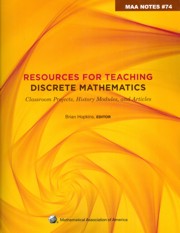Book contents
- Frontmatter
- Introduction
- Dedication
- Contents
- I Classroom-tested Projects
- The Game of “Take Away”
- Pile Splitting Problem: Introducing Strong Induction
- Generalizing Pascal: The Euler Triangles
- Coloring and Counting Rectangles on the Board
- Fun and Games with Squares and Planes
- Exploring Recursion with the Josephus Problem: (Or how to play “One Potato, Two Potato” for keeps)
- Using Trains to Model Recurrence Relations
- Codon Classes
- How to change coins, M&M's, or chicken nuggets: The linear Diophantine problem of Frobenius
- Calculator Activities for a Discrete Mathematics Course
- Bulgarian solitaire
- Can you make the geodesic dome?
- Exploring Polyhedra and Discovering Euler's Formula
- Further Explorations with the Towers of Hanoi
- The Two Color Theorem
- Counting Perfect Matchings and Benzenoids
- Exploring Data Compression via Binary Trees
- A Problem in Typography
- Graph Complexity
- II Historical Projects in Discrete Mathematics and Computer Science
- III Articles Extending Discrete Mathematics Content
- IV Articles on Discrete Mathematics Pedagogy
- About the Editor
Coloring and Counting Rectangles on the Board
from I - Classroom-tested Projects
- Frontmatter
- Introduction
- Dedication
- Contents
- I Classroom-tested Projects
- The Game of “Take Away”
- Pile Splitting Problem: Introducing Strong Induction
- Generalizing Pascal: The Euler Triangles
- Coloring and Counting Rectangles on the Board
- Fun and Games with Squares and Planes
- Exploring Recursion with the Josephus Problem: (Or how to play “One Potato, Two Potato” for keeps)
- Using Trains to Model Recurrence Relations
- Codon Classes
- How to change coins, M&M's, or chicken nuggets: The linear Diophantine problem of Frobenius
- Calculator Activities for a Discrete Mathematics Course
- Bulgarian solitaire
- Can you make the geodesic dome?
- Exploring Polyhedra and Discovering Euler's Formula
- Further Explorations with the Towers of Hanoi
- The Two Color Theorem
- Counting Perfect Matchings and Benzenoids
- Exploring Data Compression via Binary Trees
- A Problem in Typography
- Graph Complexity
- II Historical Projects in Discrete Mathematics and Computer Science
- III Articles Extending Discrete Mathematics Content
- IV Articles on Discrete Mathematics Pedagogy
- About the Editor
Summary
Summary
We describe the Rectangles on the Board project, an adaptation of an activity for elementary and middle school students that appears in [1]. Students are challenged to determine the coloring of the instructor's 10 × 10 board, given the restrictions that (1) all 100 squares are colored in one of four colors and (2) the colors form four rectangular regions, one in each color. Our extensions of this project involve counting, symmetry, geometry, and logical reasoning. For example, given the color of some squares, students infer the color of other squares based on geometry. In turn, they use logic and their understanding of this geometry to count the minimal number of squares needed to be revealed so that they can determine all of the squares' colors. Similar reasoning leads them to a best next “guess,” when playing the game. Students use combinatorics and symmetry to count the number of ways to color the board.
Notes for the instructor
This project is suitable for mathematics courses at all levels. We have implemented versions of the activity in elementary, middle, and high school classes, as well as in undergraduate mathematics and graduate mathematics education courses. The game-like aspect of the project is engaging and appealing to students. The project can be used to spur all-class discussions, or can be used to promote cooperative learning. Depending on how deeply your class desires to delve into the activity and its extensions, it can take from one to three 50-minute class periods to complete.
- Type
- Chapter
- Information
- Resources for Teaching Discrete MathematicsClassroom Projects, History Modules, and Articles, pp. 19 - 30Publisher: Mathematical Association of AmericaPrint publication year: 2009



